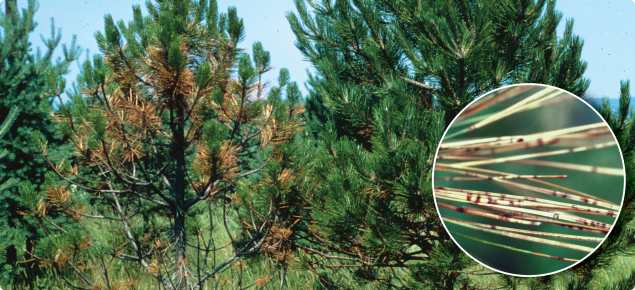What plants are affected?
- It can cause disease in at least 82 species of pines.
- Very susceptible pines include radiata pine (Pinus radiata), ponderosa pine (Pinus ponderosa), Scott’s pine (Pinus sylvestris), maritime pine (Pinus pinaster) and Japanese black pine (Pinus thunbergii).
- It is also known to attack some types of spruce, cedar, fir, larch and Douglas fir.
What do I look for?
- Reddish-brown spots and bands appear on the needles.
- The disease eventually girdles the pine needle. The needle beyond the diseased band then dies and turns brown, while the bottom part of the needle stays green.
- Infected needles eventually turn completely brown and drop from the tree.
- When older needles are lost tufts of needles at the ends of branches gives a “lions tail” appearance.
- Disease symptoms begin at the base of the tree then gradually move upwards.
How does the disease survive and spread?
- Tiny black fungal fruiting bodies appear in infected needles.
- Thousands of spores are produced when the weather is cool and wet.
- Spores spread from plant to plant by splashing of rain drops and wind.
- Long distance spread is via human movement of infected plants or plant parts.
What damage can this pest cause?
Dothistroma needle blight reduces the productivity of pine plantations and makes pines planted in gardens unhealthy and unsightly.
Status in Western Australia
Dothistroma septosporum is absent from Western Australia and is a quarantine pest. It is a prohibited organism under section 12 of the Biosecurity and Agriculture Management Act 2007.
Western Australia's Pest Freedom for Dothistroma needle blight is supported by general and specific surveillance, and specific import requirements to prevent its entry. A person who finds or suspects the presence of Dothistroma needle blight in natural reserves, plantations, forests, nurseries, or urban areas must report it to DPIRD.
What do I do if I find it?
Early detection and eradication will help protect the Western Australian forestry industry. Please make a report on MyPestGuide or contact the Pest and Disease Information Service (PaDIS) to report this pest.
It is important that any suspect needle blight occurrence is reported. Early detection and eradication will help protect Western Australia’s tree plantations, and forest and nursery industries. If you find or suspect plants with needle blight, please make a report using MyPestGuide® Reporter or contact the Pest and Disease Information Service (PaDIS) to report this pest.
Report your observations
 | MyPestGuide® Reporter Pest and Disease Information Service |



